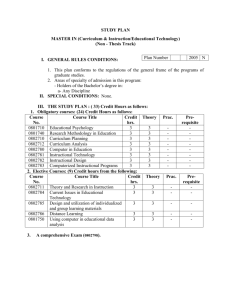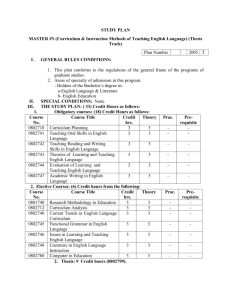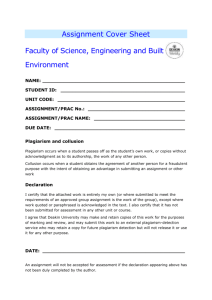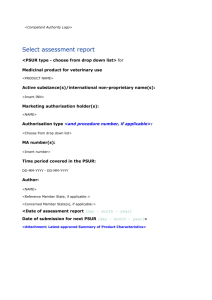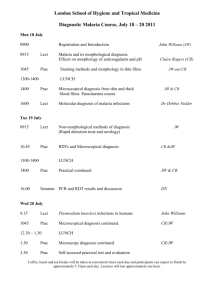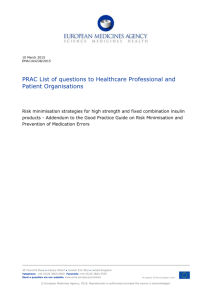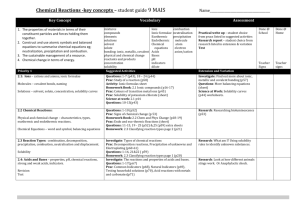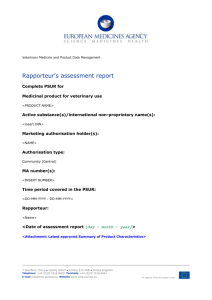PRAC periodic assessment report template (NAP only)
advertisement
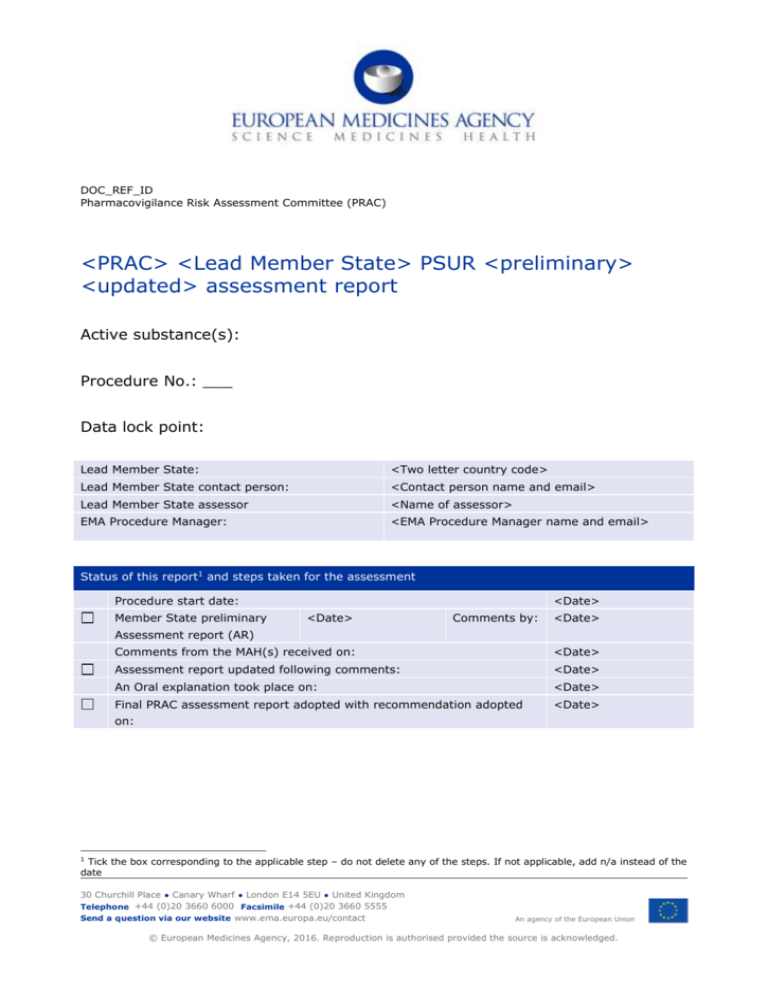
DOC_REF_ID
Pharmacovigilance Risk Assessment Committee (PRAC)
<PRAC> <Lead Member State> PSUR <preliminary>
<updated> assessment report
Active substance(s):
Procedure No.: ___
Data lock point:
Lead Member State:
<Two letter country code>
Lead Member State contact person:
<Contact person name and email>
Lead Member State assessor
<Name of assessor>
EMA Procedure Manager:
<EMA Procedure Manager name and email>
Status of this report1 and steps taken for the assessment
Procedure start date:
Member State preliminary
<Date>
<Date>
Comments by:
<Date>
Assessment report (AR)
Comments from the MAH(s) received on:
<Date>
Assessment report updated following comments:
<Date>
An Oral explanation took place on:
<Date>
Final PRAC assessment report adopted with recommendation adopted
<Date>
on:
Tick the box corresponding to the applicable step – do not delete any of the steps. If not applicable, add n/a instead of the
date
1
30 Churchill Place ● Canary Wharf ● London E14 5EU ● United Kingdom
Telephone +44 (0)20 3660 6000 Facsimile +44 (0)20 3660 5555
Send a question via our website www.ema.europa.eu/contact
An agency of the European Union
© European Medicines Agency, 2016. Reproduction is authorised provided the source is acknowledged.
General guidance
This template should be used by the PRAC or Member State for all PSUR
assessments with nationally authorised medicinal products (NAPs).
Further to the receipt of comments from the MAH(s) and other PRAC
members/Member States, the PRAC /Member State should consider whether
an updated AR is necessary. If so, the assessment conclusions should be
updated in order to fully integrate the comments received and reflect
the final position of the PRAC /Member State. The AR will then be
adopted by the PRAC with or without changes, together with their
recommendations and sent to the CMDh.
It is essential that new information presented in the PSUR requiring
updates to product information are highlighted in relevant sections and
particularly in the assessment conclusions and actions. It should
always be ensured that the recommendations for SmPC and package leaflet
changes are fully supported by the Assessment Report.
If further data or discussion is needed from the MAH to support
conclusions, they should be asked for by the Member State in the PAR.
Only questions critical to the assessment of important safety issues or
the benefit/risk balance should be considered during the assessment and
other issues should be addressed in the next PSUR.
Use INN/name of active substance when referring to other
products/comparators rather than invented name.
Guidance for EU-single assessment
* The PRAC /Member State should prepare one assessment report covering
all products involved in the procedure, including assessment of PSURs
submitted by MAHs and conclusions applicable to products within the
single assessment. In case of a LoQ, the PAR should clearly state which
MAH should address which issue.
* Taking into consideration the principles established in the HMA/EMEA
recommendations on the handling of requests for access to PSURs
(EMEA/743133/2009), it is not expected that PSUR and consequently PRAC
/Member State PSUR AR would contain commercially confidential
information. As per the HMA/EMEA recommendations, exposure data are not
considered confidential. However, with respect to personal data, date
of birth, reporting country and patient identification code are
considered confidential. Therefore, when drafting the assessment
report, the assessor should refrain from including such information in
the AR wherever possible as this information will need to be redacted
before being shared with MAH(s). Ongoing regulatory procedures or
pharmacovigilance inspections should not be discussed in the context of
EU single assessment.
* Updated RMP(s) should not be submitted and assessed with the PSUR in
the context of the EU single assessment. Any erroneous RMP submissions
will not be subject to assessment. Update of RMP should be submitted
<PRAC> <Lead Member State> PSUR <preliminary> <updated> assessment report
EMA/767739/2014
Page 2/19
and assessed by the national Competent Authorities. Although RMP cannot
be submitted with the PSUR, however the PRAC Rapporteur/Member State
may provide comments to be addressed in the next RMP update to be
provided separately with the next regulatory procedure or within a
specified timeframe.
* If required and substantiated, it is possible to propose different
outcomes in conclusions and actions and in recommendations (e.g. one
product for variation and the rest of the products part of the PSUSA
procedure for maintenance). Different recommendations can also be
issued for instance for different formulations or indications of
medicinal products or for different MAHs.
* If justified, it is also possible to have product specific requests
to be addressed in the next PSUR in the Recommendations section. In
addition, request for cumulative data review should in principle be
provided within the next PSUR to allow for an assessment at European
level.
List of data sources available for guidance
GVP Module VII, Rev.1 – Periodic safety update report
http://www.ema.europa.eu/docs/en_GB/document_library/Scientific_guideli
ne/2013/04/WC500142468.pdf
GVP Module V, Rev.1 - Risk management systems
http://www.ema.europa.eu/docs/en_GB/document_library/Scientific_guideli
ne/2012/06/WC500129134.pdfGVP Module VIII – Post-authorisation safety
studies
http://www.ema.europa.eu/docs/en_GB/document_library/Scientific_guideli
ne/2012/02/WC500123204.pdf
Implementation of the Variations Guidelines in the centralised
procedure
http://ec.europa.eu/health/files/eudralex/vol-2/2013_05_16_c2804_en.pdf
HMA/EMEA recommendations on the handling of requests for access to
PSURs (EMEA/743133/2009):
http://www.ema.europa.eu/docs/en_GB/document_library/Regulatory_and_pro
cedural_guideline/2009/12/WC500016912.pdf
<PRAC> <Lead Member State> PSUR <preliminary> <updated> assessment report
EMA/767739/2014
Page 3/19
Table of contents
1. Background information on the procedure .............................................. 6
2. <Preliminary> <Final> assessment conclusions and actions .................. 6
3. <Preliminary> <Final> Recommendations .............................................. 7
4. PSUR frequency ..................................................................................... 10
Annex: <Preliminary> <Updated> PRAC/ Lead Member State assessment
comments on PSUR ................................................................................... 11
1. PSUR Data ............................................................................................. 12
1.1. Introduction....................................................................................................... 12
1.2. Worldwide marketing authorisation status ............................................................. 12
1.3. Overview of exposure and safety data ................................................................... 12
1.3.1. Actions taken in the reporting interval for safety reasons ...................................... 12
1.3.2. Changes to reference safety information............................................................. 12
1.3.3. Estimated exposure and use patterns ................................................................. 13
1.3.4. Data in summary tabulations ............................................................................ 13
1.3.5. Findings from clinical trials and other sources ..................................................... 13
1.3.6. <Lack of efficacy in controlled clinical trials> ...................................................... 14
1.3.7. <Late-breaking information> ............................................................................ 14
2. Signal and risk evaluation ..................................................................... 14
2.1. Summary of safety concerns ................................................................................ 14
2.2. Signal evaluation ................................................................................................ 14
2.3. Evaluation of risks and new information ................................................................ 15
2.4. Characterisation of risks ...................................................................................... 15
3. Benefit evaluation ................................................................................. 16
4. Benefit-risk balance .............................................................................. 16
5. <Lead Member State Request for supplementary information> ............ 17
6. <MAH(s) responses to Request for supplementary information> .......... 17
7. Appendix: Overview of the nationally authorised products for which
PSURs were submitted in the context of this EU single assessment .......... 18
<PRAC> <Lead Member State> PSUR <preliminary> <updated> assessment report
EMA/767739/2014
Page 4/19
List of abbreviations
<PRAC> <Lead Member State> PSUR <preliminary> <updated> assessment report
EMA/767739/2014
Page 5/19
1. Background information on the procedure
This is the assessment of PSUR(s) submitted in accordance with the requirements set out in the list of
Union reference dates (EURD list) for <active substance> <combination of active substances>.
For an overview of the nationally authorised products for which PSURs were submitted in the context of
this EU single assessment, please see the appendix to this assessment report.
2. <Preliminary> <Final> assessment conclusions and
actions
•
In this section, the Lead Member State/PRAC should summarise the
assessment conclusions and relevant comments highlighted in the
AR.
•
This section should briefly summarise the main data or new
identified risks that became available, including through signal
evaluation, during the reporting interval.
•
This section should discuss whether the safety remains in
accordance with that expected or whether risks have changed. If
needed, discuss whether updates of the product information are
necessary as well as risk minimisation activity to address
specific safety concern(s).
•
The overall conclusion should be whether the Benefit Risk balance
remains unchanged per licensed indication where relevant.
•
For single PSUR assessment the comments should be active
substance specific rather than product specific.
•
For recommendation including various regulatory outcomes which
could be related to certain formulation(s), indication(s),
product(s) e.g. variation for some NAPs and maintenance for
others, the scientific summary for each outcome should include a
clear justification.
•
[For PSUSA where not all products may have a RMP, please use the
following sentence]
<MAHs which have an RMP in place should address the following issues in the next RMP update:
>
•
Change in PSUR frequency: Any proposals for changes of the PSUR
frequency,
•
List for additional monitoring: inclusion to the list for
additional monitoring should be highlighted and justified.
<PRAC> <Lead Member State> PSUR <preliminary> <updated> assessment report
EMA/767739/2014
Page 6/19
[In case of recommendation to vary the marketing authorisation only and
/or in case of suspension/revocation. If suspension/revocation, please
amend the title for the following section. Please ensure that you
justify in accordance with Art. 116 of Directive 2001/83/EC.]
Scientific conclusions and grounds for the variation to the terms of the Marketing
Authorisation(s)
In case a variation to change the product information or the conditions
of the MA is recommended, the scientific grounds need to be clearly
documented i.e. a short summary of the evidence/data underlining the
proposed changes (not just a copy of the scope) should be included
here. This should give the scientific motivation for the recommendation
of the variation in a concise manner (recommended maximum size of ½
page), as this text should be copied as the scientific conclusions for
the grounds for the variation in Annex IV to the CMDh position.
Reference to the relevant section of the Lead Member State/PRAC AR in
the annex can be included here to facilitate review by other members.
<Therefore, in view of the data presented in the reviewed PSUR(s), the <Lead Member State>
<PRAC> considered that changes to the <product information> of medicinal products containing
{active substance description as per EURD list}, were warranted.>
3. <Preliminary> <Final> Recommendations
•
For recommendation including various regulatory outcomes which
could be related to certain formulation(s), indication(s),
product(s) e.g. variation for some NAPs and maintenance for
others, scientific summary for each outcome should include a
clear justification
[In case of recommendation to maintain the marketing authorisation]
Based on the review of data on safety and efficacy by the Lead Member State and taking into account
any comments provided by the PRAC, the PRAC considers <by consensus/majority decision> that the
risk-benefit balance of medicinal products containing the active substance <name of active substance>
remains unchanged and therefore recommends the maintenance of the marketing authorisation(s).
For preliminary conclusion only:
<However, the Lead Member State considered that the MAH(s) should provide satisfactory responses
to the <request for supplementary information> detailed in annex.>
[Where the request is product-specific, it should be clearly indicated
which MAH should address the request].
[In case of recommendation to vary the marketing authorisation]
Based on the review of data on safety and efficacy by the Lead Member State and taking into account
any comments provided by the PRAC, the PRAC considers <by consensus/majority decision> that the
risk-benefit balance of medicinal products containing the active substance <name of active substance>
remains unchanged but recommends that the terms of the marketing authorisation(s) should be varied
as follows:
<PRAC> <Lead Member State> PSUR <preliminary> <updated> assessment report
EMA/767739/2014
Page 7/19
[The scope of changes to the SmPCs and Package leaflets should be
highlighted here. Alternatively, if extensive changes are proposed, a
detailed description of the new text underlined and deleted text marked
as strikethrough can be presented in an Annex].
Update of section X and X of the SmPC to add <the adverse reaction x with a frequency y> <to add a
warning on…>. The Package leaflet is updated accordingly.
The following changes to the product information of medicinal products containing the active substance
<name of active substance> are recommended (new text underlined and in bold, deleted text strike
through):
Summary of Product Characteristics
•
In case of product-specific changes, these should be presented
clearly and separately per product, formulation, indication, as
applicable.
[Add sections as relevant]
•
Section 4.4
A warning should be <added> <revised> as follows:
<Exact wording of final warning>
•
Section 4.8
<The following adverse reaction(s) should be added under the SOC <name of SOC> with a frequency
<frequency>:
< The frequency of the adverse reaction <name of ADR> should be changed to <very common>
<common etc…>
•
Section x.y
Package Leaflet
[Add sections as relevant, ensuring that the above proposed changes to
the SmPC are adequately reflected in lay terms in the package leaflet]
[In cases changes to the conditions of the marketing authorisation are
recommended, these should also be highlighted here. Alternatively, if
extensive changes are proposed, a detailed description of the new text
underlined and deleted text marked as strikethrough can be presented in
an Annex]
[In case of imposition of conditions to the marketing authorisations
e.g. PASS]
<Conditions to the Marketing Authorisation(s) for nationally authorised products:
The marketing authorisation holder(s) shall complete the below conditions, within the stated
timeframe:>
<PRAC> <Lead Member State> PSUR <preliminary> <updated> assessment report
EMA/767739/2014
Page 8/19
<Issues to be addressed in the next PSUR:
In addition, the MAH(s) should also address the following issues in the next PSUR:>
[In case of recommendation to suspend the marketing authorisation]
Based on the review of data on safety and efficacy by the Lead Member State and taking into account
any comments provided by the PRAC, the PRAC considers <by consensus/majority decision> that the
risk-benefit balance of medicinal products containing the active substance <name of active substance>
is negative and recommends the suspension of the marketing authorisation(s) on the following grounds
pursuant to Article 116 of Directive 2001/83/EC:
[Grounds for suspension]
[Select one or more from the below]
<{Product(s)} is/are harmful><, and>
<{Product(s)} lack(s) therapeutic efficacy><, and>
<the risk-benefit balance of {product(s)} is not favourable>
<the condition {specify the condition concerned} has not been fulfilled>,
Conditions for lifting the suspension of the Marketing Authorisation(s) for nationally
authorised products:
[In case of recommendation to revoke the marketing authorisation]
Based on the review of data on safety and efficacy by the Lead Member State and taking into account
any comments provided by the PRAC, the PRAC considers <by consensus/majority decision> that the
risk-benefit balance of medicinal products containing the active substance <name of active substance>
is negative and recommends the revocation of the marketing authorisation(s) on the following grounds
pursuant to Article 116 of Directive 2001/83/EC:
[Grounds for revocation]
[Select one or more from the below]
<{Product(s)} is/are harmful><, and>
<{Product(s)} lack(s) therapeutic efficacy><, and>
<the risk-benefit balance of {product(s)} is not favourable>
<the condition {specify the condition concerned} has not been fulfilled>,
[If an update of the RMP is needed]
Although RMP cannot be submitted with the PSUR, however the PRAC /Lead
Member State may provide comments to be addressed in the next RMP
update to be provided separately with the next regulatory procedure or
within a specified timeframe.
<PRAC> <Lead Member State> PSUR <preliminary> <updated> assessment report
EMA/767739/2014
Page 9/19
<In addition, MAH(s) which have an RMP in place should address the issues, as detailed in section 2 of
the Assessment report, in the next RMP update to be submitted within an upcoming regulatory
procedure affecting the RMP or at the latest by XXXX>.
4. PSUR frequency
If no changes to the PSUR frequency
<The next PSUR should be submitted in accordance with the requirements set out in the list of Union
reference dates (EURD list) provided for under Article 107c(7) of Directive 2001/83/EC and published
on the European medicines web-portal.>
If changes of PSUR frequency are proposed
PSUR frequency changed
<The frequency of PSUR submission should be revised to <xxx>. Therefore, the next PSUR should
cover the period from <dd.mm.yyyy> to <dd.mm.yyyy>. Consequently, the relevant entry in the
EURD list for medicinal products containing <active substance> will be updated and the change will be
reflected in the next published version of the EURD list. Thereafter, PSURs should be submitted in
accordance with the updated list of Union reference dates (EURD list) provided for under Article
107c(7) of Directive 2001/83/EC.
Submission of PSURs for products referred to in Articles 10(1),
10a, 14, 16a of Directive 2001/83/EC as amended
Submission of PSURs for products referred to in Articles 10(1), 10a, 14, 16a of Directive 2001/83/EC
as amended <is/is not> required <and the EURD list should be updated accordingly>.
<PRAC> <Lead Member State> PSUR <preliminary> <updated> assessment report
EMA/767739/2014
Page 10/19
Annex: <Preliminary> <Updated> PRAC/ Lead Member State
assessment comments on PSUR
<PRAC> <Lead Member State> PSUR <preliminary> <updated> assessment report
EMA/767739/2014
Page 11/19
1. PSUR Data
1.1. Introduction
This section should provide a brief statement on the active substances,
their pharmacotherapeutic action and approved indication, posology,
pharmaceutical forms and strengths.
It should also include information on the IBD/EURD, interval and
cumulative periods covered by the PSUSA. This information should be
summarised for all products/PSURs assessed in the PSUSA.
It should also highlight whether and which MAH(s) of the NAPs proposed
changes to the product information as part of the submission of this
PSUSA (to be crosschecked with Module 1.3 of the MA and regional
appendix of a PSUR).
1.2. Worldwide marketing authorisation status
This section should include brief information provided in the PSUSA
with regard to the date of the first authorisation worldwide, and in
how many countries the products are authorised, with indications(s),
authorised dose(s), if applicable. The information should be included
for each NAP which is evaluated in the PSUSA.
<X was first authorised in < A on <DD Month YYYY> and> in the EU on <DD Month YYYY>. In the EU,
X has been marketed in <A, B, C and D>. It is approved in a total of X countries.>
Lead Member State/PRAC assessment comment:
1.3. Overview of exposure and safety data
1.3.1. Actions taken in the reporting interval for safety reasons
This section should include a description of significant actions (and
reasons for these actions) related to safety that have been taken
worldwide during the interval since the last DLP, related to either
investigational uses or marketing experience by the MAH(s), sponsors of
clinical trial(s), data monitoring committees, ethics committees or
competent authorities. For further details and examples of such
actions, please refer to GVP Module VII on PSUR.
Lead Member State/PRAC assessment comment:
1.3.2. Changes to reference safety information
This section should highlight what Reference Safety Information is used
by the MAH(s) (e.g. CCDS, SmPC) and the date of the current version.
<PRAC> <Lead Member State> PSUR <preliminary> <updated> assessment report
EMA/767739/2014
Page 12/19
The changes made during the reporting interval to the Reference Safety
Information should be summarised.
The PRAC /Lead Member State should briefly comment whether any
proposals by MAHs in terms of new safety information and key risk
minimisation recommendations has been made based on the evaluation of
the information provided in the PSUSA and whether those are already
reflected in the SmPC.
Lead Member State/PRAC assessment comment:
1.3.3. Estimated exposure and use patterns
This section should provide estimates of the size and nature of the
population exposed to the medicinal product. Particularly, information
should be provided on the cumulative and on-going subject exposure in
clinical trials [PSUR: Section 5.1], cumulative and interval patient
exposure from marketing experience and if available with special focus
on the populations with no or limited exposure during clinical trials
(inclusions, exclusions, limited numbers, trial setting, and use in
special populations) and off-label use [PSUR: Section 5.2].
When relevant, these information should be stratified by indication,
formulation or route of administration, and follow-up duration), as
well as information on patterns of drug use.
Lead Member State/PRAC assessment comment:
1.3.4. Data in summary tabulations
It is not expected to include here or in attachment copies or summary
table. However, the PRAC /Lead Member State should provide a brief
comment on the outcome of the review of the data in summary tabulation:
for example, if there were any “striking” adverse reactions reports
that would warrant further follow-up. In case of products with
different indications and/or formulations, a separate review of data
according to indications and/or formulations may be provided.
Lead Member State/PRAC assessment comment:
1.3.5. Findings from clinical trials and other sources
This section should provide a brief summary of the clinically important
emerging safety and efficacy findings obtained during the reporting
interval from:
Completed clinical trials, ongoing clinical trials, long-term
follow-up, other therapeutic use of medicinal product and new
safety data related to fixed combination therapies. (section 7 of
the PSUR).
non-interventional studies (section 8 of the PSUR).
<PRAC> <Lead Member State> PSUR <preliminary> <updated> assessment report
EMA/767739/2014
Page 13/19
Other clinical trial/study sources (e.g. results from pool
analysis or meta-analysis of randomised clinical trials, safety
information provided by co-development partners or from
investigator-initiated trials, that were accessible to the MAH(s)
– Section 9 of the PSUR).
Non-clinical data (section 10 of the PSUR).
Literature (section 11 of the PSUR).
Other periodic report (section 12 of the PSUR).
Medication errors
Lead Member State/PRAC assessment comment:
1.3.6. <Lack of efficacy in controlled clinical trials>
This section should summarise data from clinical trials indicating lack
of efficacy, or lack of efficacy relative to established therapy(ies).
Lead Member State/PRAC assessment comment:
1.3.7. <Late-breaking information>
In this section the assessor should comment on any potentially
important safety, efficacy and effectiveness findings that arose after
the data lock point of the PSUR.
Lead Member State/PRAC assessment comment:
2. Signal and risk evaluation
2.1. Summary of safety concerns
In this section, the “ baseline” (i.e. at the start of the reporting
period) important safety concerns by including the summary table in
line with section 16.1 of the PSUR as well as the RMP where applicable.
2.2. Signal evaluation
•
Tabular overview of signals: new, ongoing or closed during the reporting interval <dd.mm.yyyy
to dd.mm.yyyy>.
Signal
Date
Status
Data
Source or
Reason
Method of
Outcome,
term
detected
(new,
closed (for
trigger of
summary
signal
if closed
ongoing or
closed
signal
closed)
signals)
New
MMM/YYYY
Stroke
MMM/YYYY
evaluation
Spontaneo
Brief
Review
us
summary
cases,
of key
epidemiolo
<PRAC> <Lead Member State> PSUR <preliminary> <updated> assessment report
EMA/767739/2014
Page 14/19
Signal
Date
Status
Data
Source or
Reason
Method of
Outcome,
term
detected
(new,
closed (for
trigger of
summary
signal
if closed
ongoing or
closed
signal
closed)
signals)
evaluation
data and
gical study
rational
for further
evaluation
For explanatory notes, please refer to GVP Module VII on PSURs section
VII.B.5.15 and appendix 2.
The PRAC /Lead Member State should comment on the signals classified by
the MAH(s) as new, ongoing and closed during the reporting interval.
The PRAC /Lead Member State should critically assess the evidence
presented in support of MAH(s) conclusions on the safety signals. It
should be made clear where the PRAC /Lead Member State does not agree
with the outcome of the MAH’s signal evaluation and/or considers
further actions are needed. The PRAC /Lead Member State should also
consider whether other signals should have been evaluated by the MAH(s)
(e.g. further to review of Eudravigilance data).
Lead Member State/PRAC assessment comment:
2.3. Evaluation of risks and new information
In this section, the focus should be on new risk information evaluated
in the PSUSA other than signals (e.g. literature, previous request for
monitoring etc...).
Where new risks are identified, there should be consideration of
whether these might be classified as ‘important’ or ‘other’ risks and
whether any action (e.g. update of product information) are warranted.
Lead Member State/PRAC assessment comment:
2.4. Characterisation of risks
This section provides information in case of changes to the safety
profile/summary of safety concerns (in section 2.1) have been
identified further to the above signals and risk evaluation.
Otherwise, it is sufficient to state that the safety concerns remain
unchanged (e.g. if the information on the risks has only been updated
with most recent data with no consequence on the known safety profile).
Lead Member State/PRAC assessment comment:
<PRAC> <Lead Member State> PSUR <preliminary> <updated> assessment report
EMA/767739/2014
Page 15/19
3. Benefit evaluation
This section can include a brief summary of the MAH(s) benefit
evaluation submitted by the MAH(s) in section 17 of the PSUR.
Further elaboration on the benefits may be required in case the
benefit-risk balance is considered changed during the assessment of the
PSUR (e.g. recommendation for restriction of indication or revocation.
In that case, the PRAC /Lead Member State should discuss here the
important baseline efficacy and effectiveness information, the newly
identified information on efficacy and effectiveness in order to
characterise the benefits.
4. Benefit-risk balance
This section should represent the views of the PRAC /Member State on
the benefit-risk balance of the medicinal product, taking into account
data presented in the PSUR and the arguments put forward by the MAH(s)
in the section “Integrated Benefit-risk Analysis for Approved
Indications” of the submitted PSUR(s).
Separate benefit-risk evaluation should be provided for each indication
of the medicinal products authorised in more than one indication.
If no new safety concerns or change in benefits have been identified in
the PSUR assessment, this section should be concise (i.e. to indicate
that the benefit-risk balance remains unchanged).
In case a full appraisal of the benefit-risk is warranted based on
important safety concerns and/or change of benefits during the
reporting interval period, the benefit/risk evaluation should be
presented in a structured manner (i.e. Beneficial effects and
uncertainty in the knowledge about the beneficial effects, Unfavourable
effects and Uncertainty in the knowledge about the unfavourable
effects, followed by the balance in line with other assessment report
templates).
General guidance on how to describe the benefit-risk assessment:
•
Do not repeat results extensively, these are described in detail
elsewhere. Just mention the conclusions, i.e., which are the key
favourable/unfavourable effects that have been observed. Avoid
that this section becomes the “summary of the summary”. For
products approved for more than one indication, benefit-risk
profiles should be evaluated and presented for each indication
individually. If there are important differences in the benefitrisk balance among populations within an indication, benefit-risk
evaluation should be presented by population, if possible.
•
The key benefits and risks considered in the evaluation should be
specified since not all benefits and risks contribute importantly
to the overall benefit-risk evaluation. The information
<PRAC> <Lead Member State> PSUR <preliminary> <updated> assessment report
EMA/767739/2014
Page 16/19
presented in the previous benefit and risk sections should be
carried forward for integration in the benefit-risk evaluation.
•
The strengths, weaknesses, and uncertainties of the evidence
should be considered when formulating the benefit-risk
evaluation. Describe how uncertainties in the benefits and risks
impact the evaluation.
•
Discuss the need for further studies or need for restrictions to
product availability or usage, or any other conditions or
measures aiming to improve the benefit-risk balance and reasoning
for these measures.
•
Conclude on the overall “benefit-risk balance” for the active
substance and for different indication if necessary.
•
Discuss the need for changes to the frequency of PSUR submission.
•
Consider if the substance is under the additional monitoring list
and if any changes are warranted on that respect.
5. <Lead Member State Request for supplementary
information>
This section should be included in the Lead Member State’s preliminary
AR only for the MAH(s) to address during the comment phase.
[Requests specifying the exact MAH (NAP) who should address them should
be clearly identified].
Considering the TT (15 days for Lead Member State after receipt of
comments to update AR), only questions critical to the assessment of
the benefit/risk balance should be considered. Other questions should
be included in the recommendations to be addressed in future PSURs.
6. <MAH(s) responses to Request for supplementary
information>
[Separate assessment of the responses from each MAH (NAP) should be
provided].
Lead Member State/PRAC assessment comment:
<PRAC> <Lead Member State> PSUR <preliminary> <updated> assessment report
EMA/767739/2014
Page 17/19
7. Appendix: Overview of the nationally authorised products
for which PSURs were submitted in the context of this EU
single assessment
<PRAC> <Lead Member State> PSUR <preliminary> <updated> assessment report
EMA/767739/2014
Page 18/19
Product Name (in
MRP/DCP
authorisation country)
Authorisation
National Authorisation Number
MAH of product in the
Member State where
member state
product is authorised
number
<PRAC> <Lead Member State> PSUR <preliminary> <updated> assessment report
EMA/767739/2014
Page 19/19

